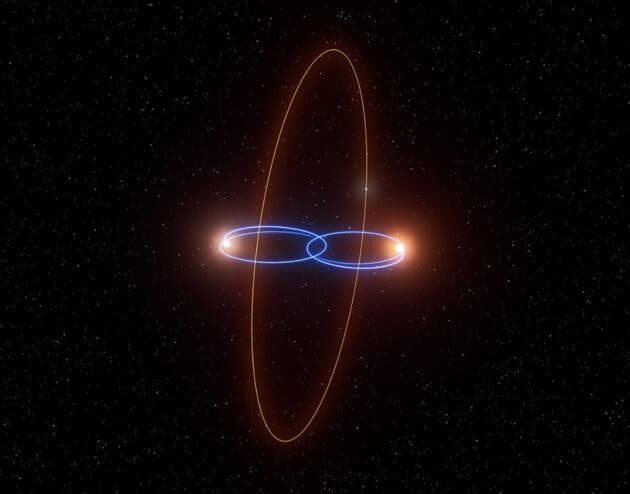University of Wuerzburg Orchestrates Swarm of Robots and UAP-Camera for Mars Exploration

Copyright/Source: Kevin Gill (via WikimediaCommons) CC BY-SA 2.0
Inhalt
Wuerzburg, Germany – The planned German Mars mission “VaMEx” is taking further shape. Researchers at the University of Wuerzburg are involved in the project, which is now being funded by the federal German government. The project focuses on exploring caves in the Valles Marineris canyon and – for the first time – includes the search for unidentified aerial phenomena (UAP) in the Martian sky.
Stretching 3,000 kilometers long, 600 kilometers wide, and up to eight kilometers deep, the vast Martian valley of Valles Marineris is one of the most striking surface features on the Red Planet.

Copyright: NASA
Massive Martian Canyon in Focus
Valles Marineris is also the focus of the research initiative by the German Aerospace Center (DLR) with the working title „VaMEx“ (Valles Marineris Exploration). The goal of this targeted German Mars mission is to explore the rift system and search for signs of life. To achieve this, the DLR plans to deploy a swarm of autonomous, interconnected robots on Mars. These robots will operate on the surface, into caves, and in the air, capturing images, taking measurements, and collecting additional data.
Particularly, caves are not only interesting locations for potential Moon or Mars bases; they likely offer favorable conditions for the development and protection of life from cosmic radiation and extreme temperatures.
A team from the Chair of Space Technology at the Julius Maximilian University of Wuerzburg (JMU) is also involved in the planned exploration of Valles Marineris as part of the VaMEx-mission. Their task is to develop a communication concept for the robot swarm. With funding from the Federal Ministry for Economic Affairs and Climate Action, the DLR is also supporting the VaMEx-3 subproject „MarsSymphony“ at JMU with approximately 1.5 million euros (funding code 50RK2451A).
– Read the exclusive GreWi interview, where Professor Hakan Kayal explains the UAP aspects of „VaMEx 3 – MarsSymphony.“ …in Deutsch …in ENGLISH
A Sensor and Data Network for Mars
„We named our subproject ‚VaMEx 3 – MarsSymphony‘ because the goal is to harmonize the individual elements of the robot swarm like an orchestra,“ explains project leader Professor Hakan Kayal. „The swarm includes mobile robots in the air and on land, a stationary gateway on the ground serving as the command center for communication, and a satellite simulator for data exchange with Earth.“

Source/Copyright: Clemens Riegler, University of Wuerzburg
When the ground robots enter caves, they are shielded from the Martian surface and cannot directly communicate with the gateway or the orbiter. Therefore, the concept also includes repeater stations that relay the collected images and data along a transport chain—from the robot in the cave to the gateway on the planet’s surface.
Twirling Drones Like Maple Seeds
The swarm also includes so-called autorotation bodies. These are dropped from the air and collect data as they gently glide to the ground. This is made possible by their special design: the elongated bodies are shaped like maple seeds. They have a wing and rotate around their own axis, allowing them to float gently downward. Their flight path is controllable, enabling them to be distributed over a wide area and used as sensor or repeater networks.
MarsSymphony project manager Clemens Riegler is particularly excited about the use of autorotation bodies. He helped develop these devices as a student, starting in 2016 in the DLR’s Rexus-Bexus program and with the Würzburg student group WüSpace e.V., which allows students to participate in aerospace projects. In his doctoral work, Riegler is further developing these bodies: „It’s very gratifying to see that the DLR is recognizing this work and that it has now become part of a project for exploring Mars!“
All-Sky Camera Searches for Known and Unknown Phenomena in the Martian Sky
The robotic Mars orchestra also includes another unique feature: the stationary gateway will be equipped with a camera that keeps an eye on the Martian sky. „All previous Mars missions have focused on the planet’s surface, but for the first time, we also want to look upward,“ says Hakan Kayal. And there will likely be much to observe: cloud formations, meteor entries, lightning, and other transient phenomena.
An international research team recently concluded, in June 2024, from seismic data that basketball-sized meteorites hit Mars almost daily. „We could further support this with data if we were able to film meteorite entries with our UAP camera and correlate these events with seismic signals,“ Kayal explains.
However, the sky-watching camera is not just meant to document Martian meteorites. The abbreviation UAP (formerly UFO) stands for „Unidentified Anomalous Phenomena.“ The camera’s name is derived from its ability, using artificial intelligence (AI), to specifically search for unknown aerial phenomena similar to those observed on Earth. „Integrating a sky observation camera system into the gateway represents a significant development step toward a detection system for transient phenomena in the Martian atmosphere, as well as for studying UAPs. In the future, the novel sky observation camera could also detect UAPs on Mars,“ Kayal adds.
Terrestrial Predecessors for the Martian UAP Camera
The UAP camera system for Mars is based on similar systems developed by Kayal and colleagues, which, with the help of AI, are designed to distinguish natural and conventional flying objects from unknown and anomalous phenomena, documenting the latter. These systems are already in use in Norway’s Hessdalen region and on the roof of the University of Würzburg campus.

The researchers at JMU have even successfully placed an AI-based camera system aboard a small satellite in Earth orbit, which, while not searching for UAPs, is designed to identify anomalous surface structures on planets and other celestial bodies.

Copyright: A. Müller for grenzwissenschaft-aktuell.de
Professor Kayal’s „Interdisciplinary Research Center for Extraterrestrial Studies“ (IFEX) at JMU is also the only university research center in the world where UAP (Unidentified Aerial Phenomena) are officially researched as part of the university’s academic canon (as reported by GreWi HERE). With „MarsSymphony,“ the German federal government is, for the first time, funding a scientific project explicitly connected to unidentified aerial phenomena (UAP).
– Read the exclusive GreWi interview, where Professor Hakan Kayal explains the UAP aspects of „VaMEx 3 – MarsSymphony.“ …in Deutsch …in ENGLISH
In 2025, an analog mission will be conducted in a terrestrial quarry to test whether the robot swarm functions as planned. During this simulation, the Würzburg UAP camera will play a critical role. Its video recordings of the sky will provide sufficient data volume to test the reliability of the communication system.
If the analog mission is successful, a follow-up project could adapt the hardware to meet the requirements for deployment on Mars. There, the instruments will face harsh conditions: the atmosphere is thin, the average temperature is minus 63 degrees Celsius, and massive dust storms regularly sweep across the planet’s surface.
© grenzwissenschaft-aktuell.de














